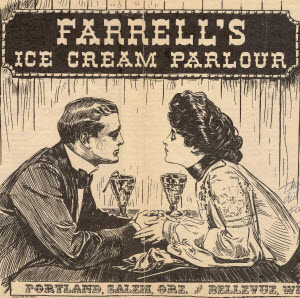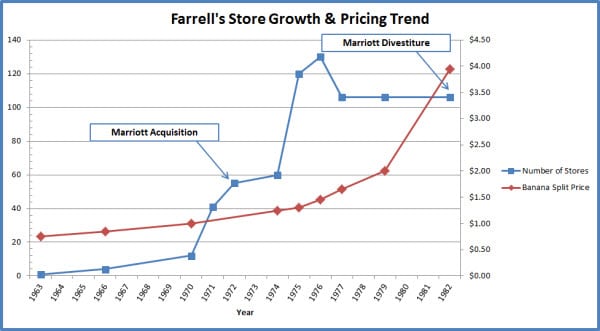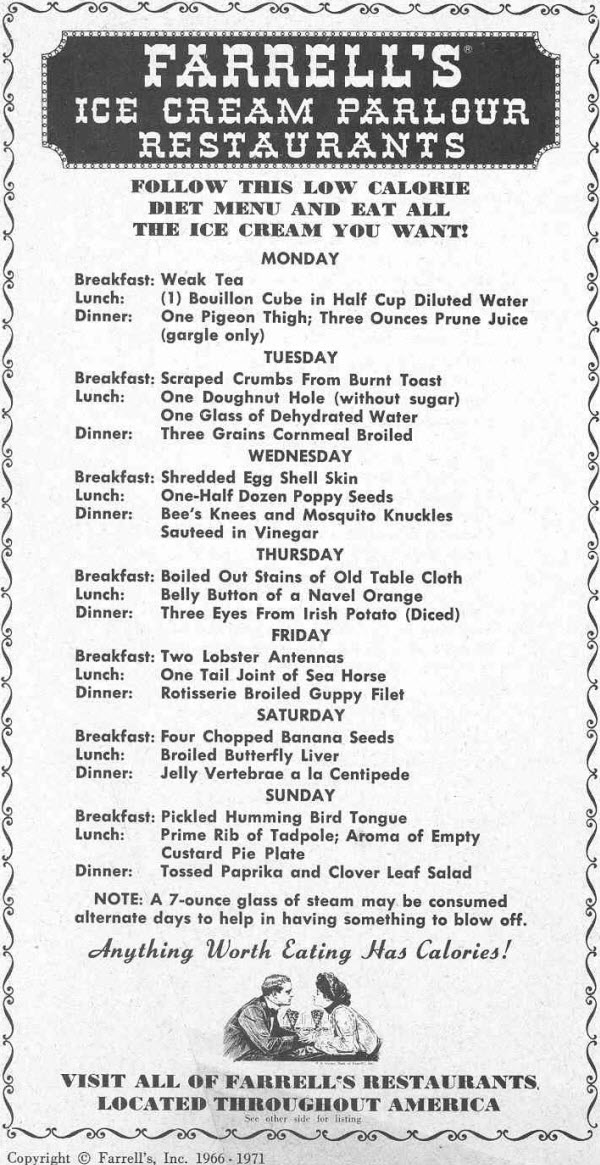Cornell University’s School of Hotel Administration had an operations analysis class where Bob Farrell visited as a guest lecturer. As a student, I was fortunate to participate in that amazing session.

The establishment that hooked millions of kids to a lifetime of chilled confectionary dependency – the Tin Roof Sundae was my gateway drug of choice
Image Credit: happyitis.biz
Farrell explained that the brand’s birth was inspired by a family trip and an inability to get ice cream one evening while visiting Seattle’s Olympic Hotel, then managed by then Western International (the predecessor to Westin.)
Farrell went on to attribute its death to the inability of the company that acquired it to understand the brand, or its operations.
Farrell’s concept was simple – a bar for kids. It wasn’t just about Ice Cream and free sundaes on your birthday. It was about fun & excitement. The cost of ice cream was similar to the cost of alcohol. The kid mixing up the sundaes performed the same role as a bartender. He wanted a cool, fun place for high school and college kids to work.
The menu was kept simple – college and high school kids are not normally accomplished chefs. The menu featured a lot of items that were relatively easy to prepare with minimal training.
But the true genius was the marketing – it targeted kids, but it was specifically designed to appeal to three generations of kids. It was obviously “The“ spot for kids birthday parties, but it was also a place the whole family could agree on for a casual family dinner. Finally, grandparents loved Farrells both as a spot that ensured happy grandchildren, but the 1890’s theme also played a somewhat nostalgic role in their own childhood memories.
Farrell’s core philosophy was “Our business is not what we sell, it is who we serve.” He had that revelation with after receiving a letter from a customer of an early store in Bellevue, Washington (an early franchise and my favorite childhood bar dining establishment):
Dear Mr. Farrell,
I’ve been coming to your restaurant ever since it opened, I really love the place.
I love your ice cream, I love the fun, I love your hamburgers – they’re the best!
I love your pickles – they are the best pickle in Seattle. I always ask for an extra pickle and they always give me one.
Today, Mr. Farrell, I came in, asked for my usual, and asked for an extra pickle from the young waitress.
Well, I don’t know where she got the idea, but she said – I’ll have to sell you an extra side of pickles for $0.75.
Well, if that’s the way you are going to run your restaurant, Mr. Farrell, I’m not coming back.
Farrell made the internal service motto of the company “Give them the Pickle!” That, even more than pricing, ice cream or fun, was the secret to the entrepreneurial success of Farrell’s Ice Cream Parlours.
The first Farrell’s Ice Cream Parlour opened in Portland in 1963. With six stores, in 1968, Farrell started to successfully franchise the brand. In 1973, having never experienced a store closing, Farrell sold the now 55 unit brand to Marriott for $8 million.
Marriott started making changes – big changes. They hired external consultants to help them improve profit margins for an already successful brand. Recommendations included rapid expansion, radically expanding the menu, reducing the quality of the food, increasing prices, and bringing in video games to grow ancillary revenues.
The focus was almost exclusively internal – on how the product could generate higher profit. The role the consumer played in the formula was lost.
By 1975, there were suddenly 120 stores. Most ironically, in 1975, Farrell’s produced a video that touted all of the values that had made the company great to attract franchisees. It even closed with the line “Great things never change.” Little did they know
In the video, Bob Farrell looks directly into the camera and tells the viewer:
“We have always believed that the customer, and not profit, is the purpose of our business. Sure, we need to make a profit to stay in business, but our real goal is satisfying the customer, and at the same time, making a contribution to the community.”
Farrell’s new leadership was oblivious to the fact that they were ignoring the strategy so eloquently described in the video. All the “optimization” of the original brand concept didn’t work. Kids didn’t care about the expanded menu, but when the player piano was replaced by a salad bar, they did notice that the places weren’t nearly as much fun. Plus, the higher prices and video games alienated the parents and grandparents – an important funding source for the target market.
Farrell’s was no longer a bar for kids. Sadly, it had morphed into a less differentiated midscale restaurant competing with the likes of Denny’s, who served lower quality food at a low price point.
Worse yet, corporate ego would not permit retreat back to the original concept. Stores were renovated and further distanced from the original theme – in most cases, neutral colors ruled – perhaps to reduce the cost to potential buyers when they failed.
After less than a decade, in 1982, Marriott sold a struggling and unprofitable brand of 106 restaurants to a group of private investors for an undisclosed sum. The new owners then rode the mortally wounded brand into the ground less than five years later.
The following chart tracks the growth in the number of stores and the price of a banana split over the period 1963 through 1982.

The number of stores went up, and eventually, so did menu prices as the group struggled to extract more revenue from a declining number of patrons.
While Bob Farrell was still involved with the brand in a consulting capacity, his voice as the acquired founder apparently fell on deaf ears. When the Operations Analysis class met with him in the fall of 1980, he openly declared that Marriott had killed the brand – despite the fact that almost two years would pass before the brand was finally sold off.
Marriott should have listened, Bob Farrell’s insights into the success of his legendary brand were invaluable. In fairness to Marriott, I think they did learn a valuable lesson. The acquisition of the Ritz-Carlton brand in 1995 featured very little tinkering with the guest experience, while Marriott’s efficiency experts worked over the back of house processes to make the operation more efficient.
Farrell’s business philosophy is best described in his own words: “Profit is the consequence of success, not the cause of it. The minute you start looking at the cash register and not the customer, you lose sight of success.”
He also made that philosophy actionable by breaking it down into a simple message for the service industry (I call them ACTS):
Attitude
“Choose your Attitude. How you think about customers, is how you will treat them.”
Consistency
“Set high standards, and stick to them. Customers return because they like what happened the last time.”
Teamwork
“Look for ways to make each other look good. In the end, everything winds up in front of the customer!”
Service
“Make serving others your #1 Priority. Service is a noble profession, be proud of what you do.”
The above is a proven recipe for developing a customer-centric workforce
But perhaps the greatest contribution of Farrell’s to history is its fabled “Low Calorie – All the Ice Cream You Want Diet”
Here it is, unabridged, in all its glory:

Dieting should never be about depriving oneself of those precious few things that make life worth living. So while some compromise may be required to reduce caloric intake from other foods and/or meals, this diet proves one need never curtail their ice cream intake.
Image Credit: happyitis.biz
Farrell’s, like Southwest Airlines, another great brand born in the 1960’s, was smart enough not to take itself too seriously, allowed its employees to have fun, strove for operational simplicity, and always put the needs of the customer first.
Southwest survives today because of its dedication to its ideals. Farrells lost its way when its new corporate bosses allowed the company to become self-absorbed. And the market showed them who the real bosses were.
A few Farrells Ice Cream Parlours remain today in California, largely continuing the tradition of the original Farrells establishments. I would be fairly certain they don’t charge for an extra pickle.
If you see one, stop in. Try a Tin Roof Sundae and let me know if partaking of a genuinely legendary brand experience doesn’t make your day just a little bit happier.




